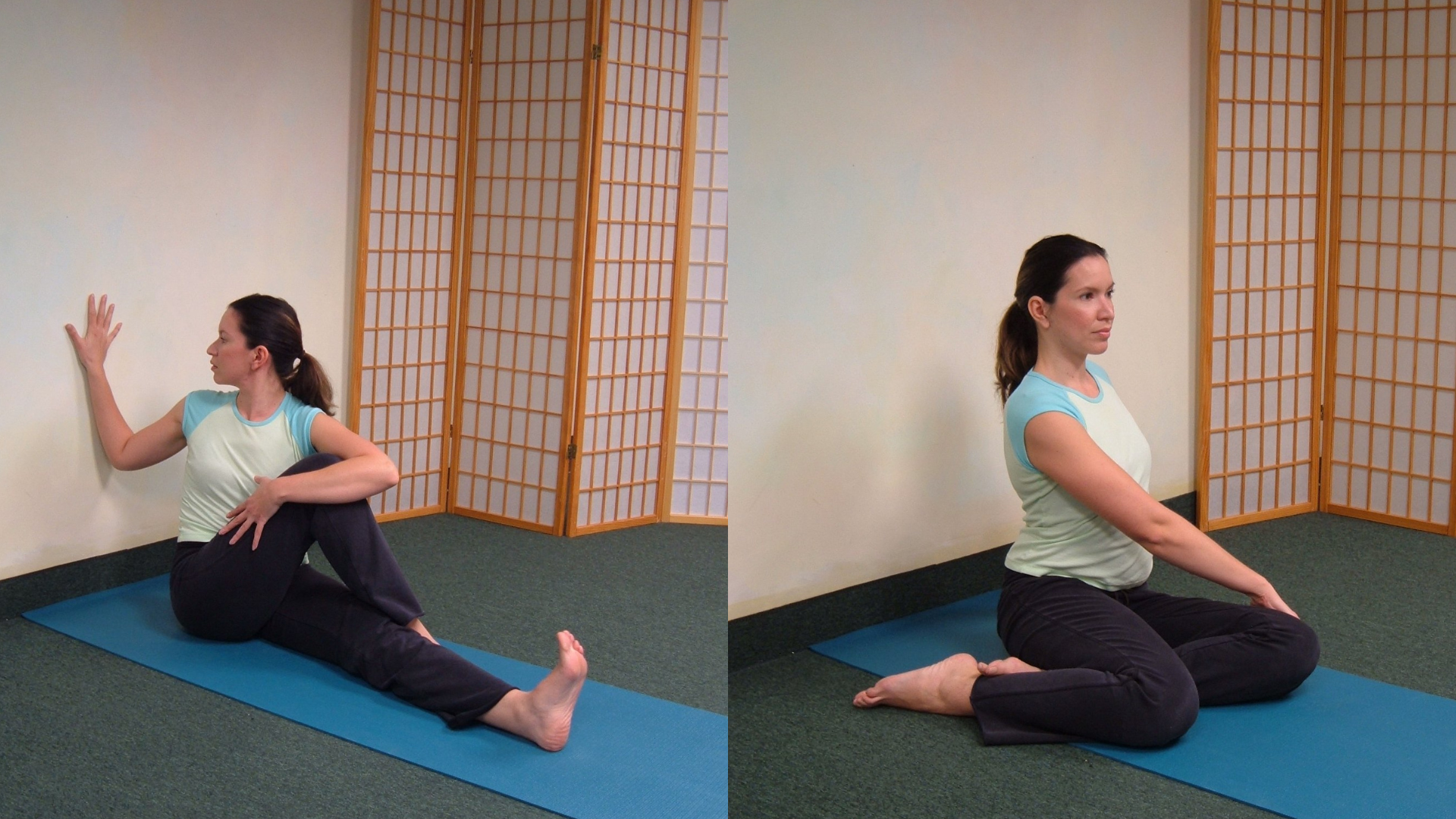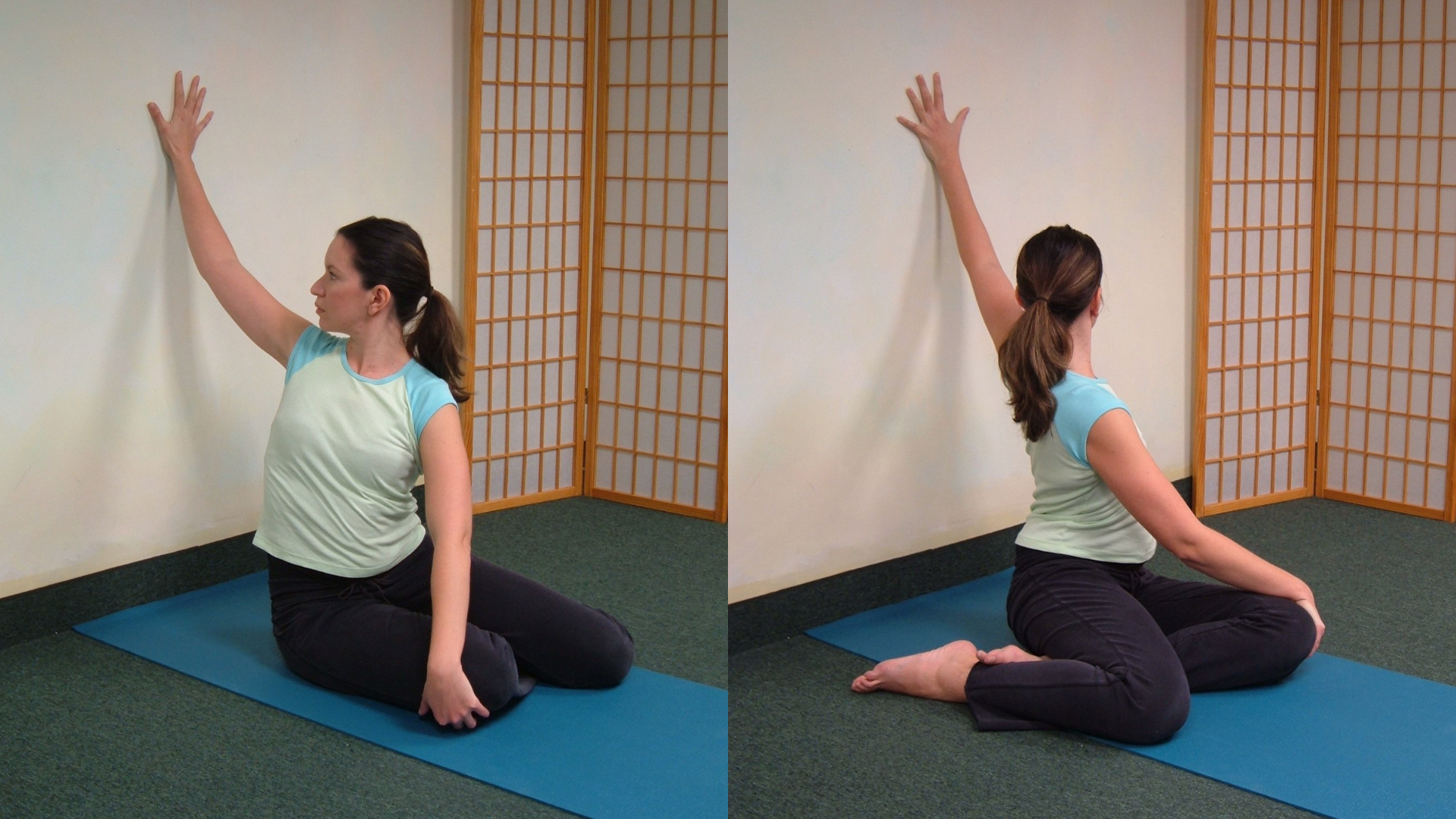Mindful Twisting: Seated Spinal Twist Pose at the Wall

Article At A Glance
It takes time for lifelong patterns to be reversed. Our bodies acquire certain feelings and forms based on the repetitive movements we make—conscious or unconscious. How we sit, stand, sleep, eat, and walk all affect our posture and physical holding patterns. Assuming a “hurry up and relax” attitude with these yoga seated spinal twist postures will create more tension than relaxation. It may have taken you a long time to accumulate tension and contraction, and it may take a while to undo what has been done.
Using the wall for some leverage in these seated spinal twist variations can add more torque and twist into your spinal rotation. So, titrate your twist! Move into the twist poses in small, slow, and gradual movements. Avoid over-twisting.
Deep, slow rhythmic breathing focused on the exhalation has been shown to contribute to a more significant relaxation response (parasympathetic branch of the autonomic nervous system). We physically relax in response to the signals our brain and nervous system (and other systems) send throughout our bodies.
Our brain communicates via a system of proprioceptors, or nerve endings, in muscles, tendons, and joints. Breathing consciously and slowly is of utmost importance while practicing yoga poses like the seated spinal twist.
As you practice, keep these words in mind: unfold, undo, unwind, unravel, melt, surrender, soften, lengthen, elongate, stretch, and relax. Allow yourself extra time in the pose. Feel as if you had all the time in the world to explore your body.
Benefits and Experiences of a Seated Spinal Twist
- Promotes openness and expansion in the waist, ribs, and sides of your body.
- Stretches the muscles around the spinal column.
- Stretches the muscles of the arms and shoulders.


- Compresses and massages internal organs and the digestive system.
How to Practice Seated Spinal Twist at the Wall
- Sit facing away from the wall less than one arm’s distance—experiment with what works based on your own body proportions.
- Base leg: bend the bottom leg and drop your knee forward and outer thigh on the floor. If this movement feels difficult or your hips lift off the floor, follow the instructions for a different leg variation described below.
- Top leg: cross your top leg over the bottom bent leg. Place that foot on the outside of your knee or to the inside of the shin for a more accessible stretch.
- Hug the raised knee firmly with your opposite arm. For yet a deeper twist variation: press your elbow to the outside of your raised knee.
- Reach your other arm behind you to the wall. Place your hand about shoulder height or less on the wall behind you. The wall helps you leverage into the twist. Caution: do not over-twist.
- Keep your hips planted and stable. Lengthen your lower back by slightly tipping your pelvis forward and raising your rib cage.
- With your spine erect, slowly turn your torso toward the wall from your lower body to your upper body. First, the abs, lower ribs, lower back, then the upper ribs, mid-back, shoulders, neck, and turn the eyes last.
- Keep your chin parallel to the floor.
- Broaden your chest and press your shoulder blades down from your ears.
- Twist more deeply on your exhalation and elongate your spine on your inhalation.
- Release the twist and face forward. Uncross your legs and return to a seated position.
- Repeat the pose on the other side of your body.
Suggestions for Safe TwistIng
Yoga Prop Suggestions
- Sit on a yoga block or a folded blanket if you have trouble crossing your legs.
Suggestion for Visual Focus
- Let your eyes focus on a point eye level on the wall in the back of you or on the thumb of your back hand.
- Allow your eyes to close and focus on sensations and feelings.
Imagery for Finding alignment
- Imagine that you are gently squeezing and wringing out every drop of stress and tension from your body as you revolve around your central axis.
“Home Play” Experiments—Explore and Deepen Your Seated Spinal Twist

Experiment with all these varied arm and leg positions in the twist. Try crossing or uncrossing your legs. Play with hugging your front leg, sometimes loosely, sometimes tightly.

Twist very slowly, about a half or an inch at a time. Initiate the twist from behind your lower body. Let the twist then move up into your waist, ribs, shoulders, and finally, your neck.
Precautions for safe twisting
- Do not twist deeply in the lower body if you are pregnant.
- Use caution and consult your doctor if you have back/spinal compromises or injuries or have recently had surgery.
Also, read...
Change Your Perspective of Pelvic Tilting: How the Transversus Abdominis Can Help
4 Ways to Practice Locust Pose
5 Keys to Healthy Neck Alignment in Cobra Pose (Bhujangasana)
Related courses
Breath as Medicine: Yogic Breathing for Vital Aging
Yoga and Myofascial Release: Releasing Chronic Tension with the Bodymind Ballwork Method

Stephanie Ann Pappas is the author of Yoga at Your Wall, Yoga Posture Adjustments and Assisting, and Las Posturas de Yoga in Spanish. Her books are available on amazon.com and other online bookstores.
Stephanie has been practicing yoga and meditation since 1982. She has directed spiritually oriented yoga teacher trainings since 1998, and in 2002 she founded the Devalila Yoga teacher training school, a 200-hour registered program which as certified over 300 teachers.



